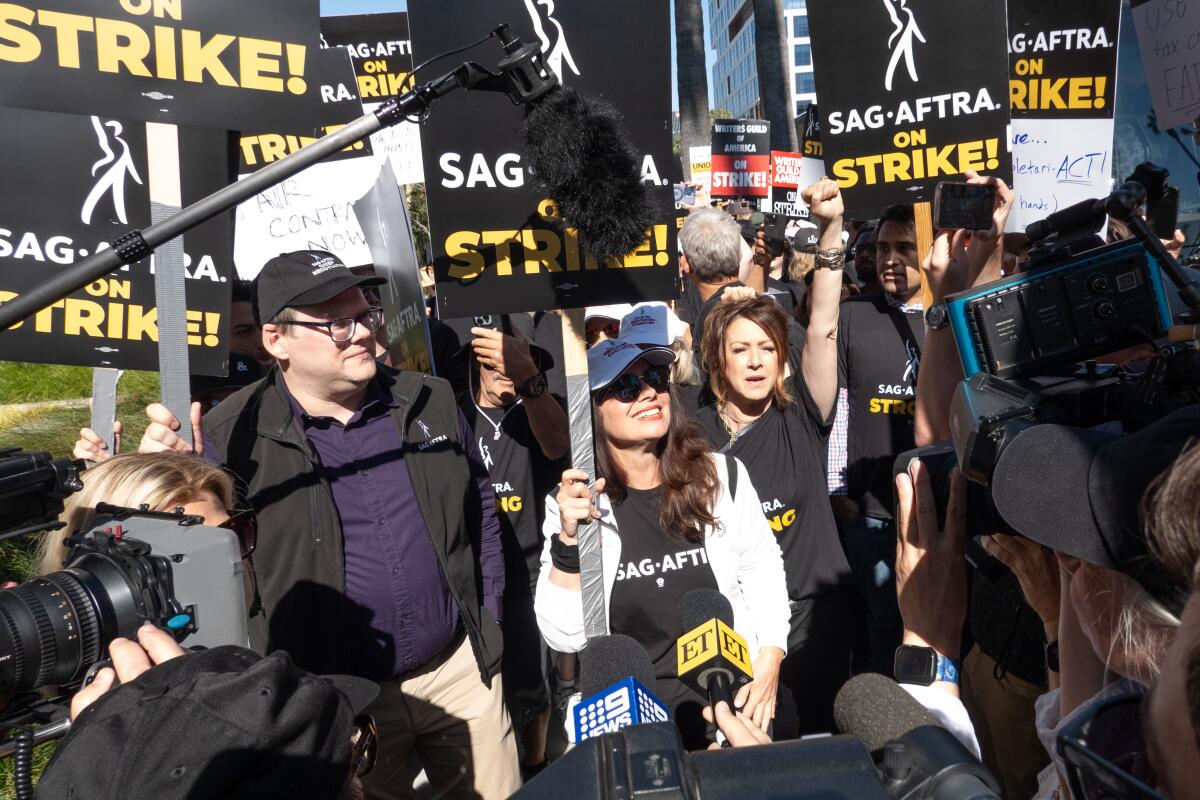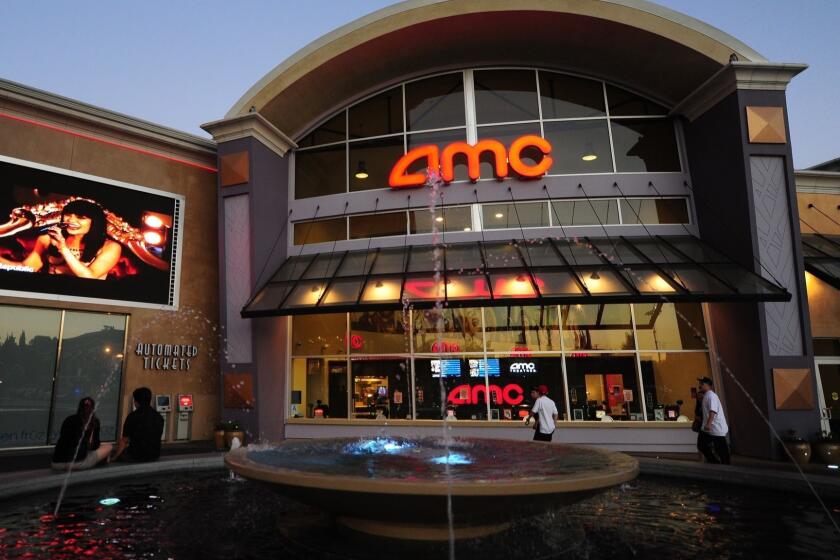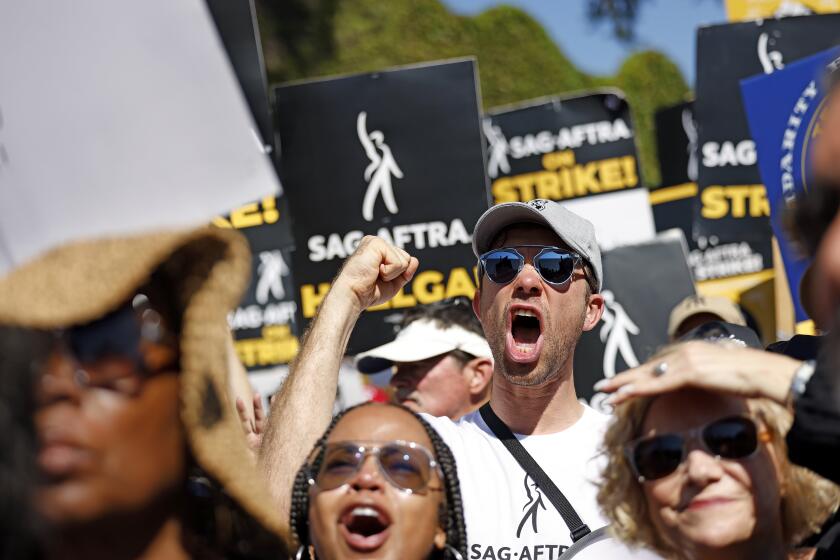The strikes are over, but Hollywood’s lost year is a tipping point for the industry

- Share via
Six months after picket lines first formed outside iconic studio gates, Hollywood can finally return to work.
Wednesday’s hard-fought tentative agreement on a new contract between SAG-AFTRA and studios sparked jubilation, with performers flocking to local watering holes, including a brewery near the guild’s Wilshire Boulevard headquarters. Sound stages mothballed since last spring are poised to reopen, welcoming back thousands of actors and film crew members.
There was palpable relief among studio executives who were desperate to salvage the current television season, awards shows, film festival appearances and their 2024 movie releases. Union leaders hailed the proposed three-year accord, saying it would make acting a more sustainable career.
Over the last three years, the movie industry has weathered a pandemic and two Hollywood strikes. What does the future hold for theaters?
But the industry isn’t expecting to quickly bounce back. Nor will it be the same as it was before the town shut down.
Interviews with more than a dozen industry veterans — including executives, talent agents and producers — revealed deep anxiety about the turmoil in the business as consumers switch to streaming, abandoning lucrative pay-TV bundles that have long buoyed the industry.
Some said 2023 might be remembered as a lost year of production and an industry tipping point.
“We are definitely past the high-water mark of crazy money chasing content to feed streaming platforms,” entertainment lawyer Robert Schwartz said. “There won’t be the same volume of content created or ordered — and that means fewer jobs for talent and for everybody.”
Even before Writers Guild of America members walked out in early May, there were signs of a major contraction. Walt Disney Co. early this year began cutting thousands of jobs and trimming spending by billions of dollars — a harbinger that television’s nearly decade-long production boom to launch new streaming services, a period known in the industry as “peak TV,” had reached its end.
Producers last spring began slowing orders for TV show and film projects as Wall Street demanded streaming profits.
The twin strikes accelerated the trend. When members of the Screen Actors Guild-American Federation of Television and Radio Artists joined the writers’ walkout in mid-July, scripted productions almost entirely shut down. An estimated 45,000 jobs vanished from the entertainment and sound recording industry payrolls since May, according to the U.S. Bureau of Labor Statistics.
If approved by union members, the tentative contract would end a strike that lasted nearly four months and shut down Hollywood film and TV productions.
It’s not yet clear what shape and size the recovery will ultimately take. Some productions will quickly ramp up, studio executives said, while others might not return for weeks — if at all.
“It’s not going to be the flip of a switch,” said David Kramer, president of United Talent Agency. “There are a lot of different forces at work that are going to have an impact on the volume of the business.”
SAG-AFTRA’s television and theatrical negotiating committee placed the value of the new contract at more than $1 billion, which includes higher wages, increased contributions to the guild’s pension and health fund, bonuses for successful streaming shows and protections from the threat of artificial intelligence, issues that many members considered to be existential.
The proposed contract will go a long way in “addressing the impact that the streaming business model has had on members,” SAG-AFTRA chief negotiator Duncan Crabtree-Ireland said Wednesday.
“Just a very basic middle class career as performers has been almost out of reach,” he said. “When we look back ... we will say this [labor negotiation] was a moment that really changed a number of things about the industry in a positive direction.”

The Alliance of Motion Picture and Television Producers, which bargains on behalf of Disney, Netflix, Amazon Studios, Warner Bros. Discovery, NBCUniversal and others, said the deal represented “the biggest contract-on-contract gains in the history of the union, including the largest increase in minimum wages in the last forty years [and] a brand new residual for streaming programs.”
But higher labor costs — concessions won by writers and actors through months of bargaining with the studio alliance — could weigh on spending decisions and prompt a further pullback in projects and production budgets, the insiders said.
Companies had already promised Wall Street they will be more disciplined in their spending after years of pouring billions of dollars into programming for streaming services to compete with Netflix. Disney, Warner Bros. Discovery, Paramount Global and others have tried to rein in spending and pare down debt from acquisitions.
Executives say they must reassess their slates and priorities. Some are waiting to see if next year brings a stronger TV advertising market with more revenue.
“Did the strike just add more cost pressure to a business that was already challenged?” Rich Greenfield, a partner and media analyst with research firm LightShed Partners, asked in an interview.
Workers in film and TV, most of whom are pro-union, have been trying to make ends meet amid a dual strike of Hollywood actors and writers.
“The harsh reality for actors, writers and all of these guilds is there’s just too much content and it’s not driving enough value for these media companies,” Greenfield said. “With the cost of production, studios are going to be cutting back on their projects.”
The industry’s output of TV shows likely peaked last year when TV networks and streamers collectively produced a record 599 shows, according to FX Networks’ annual analysis. Sources said the number of shows made during the first half of this year— before the full impact of the strikes — already was down about 10%, compared with the first six months of 2022.
Industry insiders said the number of series will decrease by about 20% next year compared with pre-strike levels, bringing the total to about 480.
“There needs to be a massive round of belt-tightening because the [previous] level of production was never sustainable,” Schwartz said.

Rich producer deals, such as director-producer J.J. Abrams’ company’s estimated $250 million arrangement with Warner Bros., could fall out of favor. Since cable programmer Discovery took over WarnerMedia from AT&T last year, the studio has slashed spending.
There will also be pressure on budgets for individual shows and movies. Sources knowledgeable of TV financials said that certain studios want to spend about $5 million to $7 million per episode for a scripted streaming show, in contrast to a few years ago when budgets were typically about 20% higher — and some costs soared above $20 million an episode.
Film executives are expected to greenlight fewer projects, largely steering clear of mid-tier budgets of $30 million to $60 million.
Executives are looking for shows less like HBO’s fire-breathing dragons epic “Game of Thrones,” showrunner Marc Guggenheim said. Instead they are embracing less-expensive procedurals, such as Netflix’s “The Lincoln Lawyer,” which appeal to mass audiences.
“When we say we’re entering a new era of fiscal responsibility, all the streamers are going to be far more picky in terms of what they decide to pick up,” Guggenheim said. “That decision-making process will probably take longer.”
Frustration, fears about the future and a high degree of mistrust continue to shape the script of Hollywood’s strikes by the WGA and SAG-AFTRA.
This week, Disney Chief Executive Bob Iger told Wall Street his company would achieve $7.5 billion in cost savings — significantly more than initially forecast — which included 8,000 job eliminations. The savings are due, in part, to the dual strikes because the company saved hundreds of millions of dollars that would have been spent on productions and marketing.
Disney expects to spend $25 billion on programming during the current fiscal year — a gargantuan sum but one that represents a $2 billion decline in the Burbank giant’s content expenditures during the fiscal year that ended in September.
Despite gains made through the proposed contract, the industry contraction could make it more difficult to find work.

However, actor, comedian and strike captain Elyssa Phillips said she was confident the sacrifices Hollywood workers made over the last six months would not be in vain. Long before SAG-AFTRA’s walkout ended, the “Silicon Valley” and “Fresh Off the Boat” actor felt like the guild had “already won.”
“A lot has been sacrificed, but for the better of the future of our industry — both for the people who come after us and for us, who are going back to better working conditions, better working environments, better work in general because it will be work that will be treated like a career and not like freelance work,” Phillips said.
She noted that the return to work would look different for various types of performers, many of whom already work other gigs to get by.
“There’s only a handful of actors that get to go back to work when all of this is over,” Phillips said during a break this week between a stint on the picket lines and her next shift waiting tables. “Everyone just goes back to auditioning and back to their normal lives. The people who wait tables will still be waiting tables.”
But, she added, “I’ve never been so excited to audition in my entire life.”
More to Read
Inside the business of entertainment
The Wide Shot brings you news, analysis and insights on everything from streaming wars to production — and what it all means for the future.
You may occasionally receive promotional content from the Los Angeles Times.

















